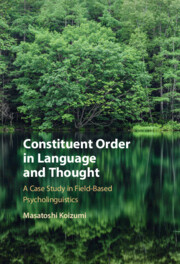Book contents
- Constituent Order in Language and Thought
- Constituent Order in Language and Thought
- Copyright page
- Dedication
- Contents
- Figures
- Tables
- Preface
- Abbreviations
- Chapter 1 Introduction
- Chapter 2 Kaqchikel Mayan
- Chapter 3 Word Order Preference in Sentence Comprehension I: Behavioral Studies
- Chapter 4 Word Order Preference in Sentence Comprehension II: fMRI Studies
- Chapter 5 Word Order Preference in Sentence Comprehension III: ERP Studies without Context
- Chapter 6 Word Order Preference in Sentence Comprehension IV: ERP Studies with Context
- Chapter 7 Basic Word Order in Language and Natural Order of Thought
- Chapter 8 Constituent Order Preference in Event Representation
- Chapter 9 Word Order Preference in Sentence Production I: Production Frequency
- Chapter 10 Word Order Preference in Sentence Production II: Time Course and Cognitive Load
- Chapter 11 Grammatical Processing and Event Apprehension
- Chapter 12 Syntactic Structure of Kaqchikel Revisited
- Chapter 13 Syntax and Processing Load
- Chapter 14 Concluding Remarks
- Book part
- References
- Index
Chapter 8 - Constituent Order Preference in Event Representation
Published online by Cambridge University Press: 19 January 2023
- Constituent Order in Language and Thought
- Constituent Order in Language and Thought
- Copyright page
- Dedication
- Contents
- Figures
- Tables
- Preface
- Abbreviations
- Chapter 1 Introduction
- Chapter 2 Kaqchikel Mayan
- Chapter 3 Word Order Preference in Sentence Comprehension I: Behavioral Studies
- Chapter 4 Word Order Preference in Sentence Comprehension II: fMRI Studies
- Chapter 5 Word Order Preference in Sentence Comprehension III: ERP Studies without Context
- Chapter 6 Word Order Preference in Sentence Comprehension IV: ERP Studies with Context
- Chapter 7 Basic Word Order in Language and Natural Order of Thought
- Chapter 8 Constituent Order Preference in Event Representation
- Chapter 9 Word Order Preference in Sentence Production I: Production Frequency
- Chapter 10 Word Order Preference in Sentence Production II: Time Course and Cognitive Load
- Chapter 11 Grammatical Processing and Event Apprehension
- Chapter 12 Syntactic Structure of Kaqchikel Revisited
- Chapter 13 Syntax and Processing Load
- Chapter 14 Concluding Remarks
- Book part
- References
- Index
Summary
Although previous studies in gesture production have claimed that the agent–patient order is the universal preference when humans think about events and describe them nonverbally, the studies have only assessed languages in which the subject precedes the object in the basic word order (i.e., SO languages). Such limited evidence is not sufficient to conclude that all humans universally perceive the world in the agent–patient order, and it cannot help us disentangle whether the apparent preference for agent–patient sequences is the result of universal cognitive factors or the influence of the word order of SO languages. To disentangle these two possibilities (i.e., the UCV and the IGV), it is crucial to examine a language in which the object precedes the subject in the basic word order. Chapter 8 reports on a gesture production experiment we conducted with Kaqchikel speakers similar to Goldin-Meadow et al. (2008), finding that Kaqchikel speakers dominantly produced agent–patient gestures. Therefore, agent–patient ordering does seem to be a universal preference for event description, which is in line with the UCV as well as the results of previous studies.
Keywords
- Type
- Chapter
- Information
- Constituent Order in Language and ThoughtA Case Study in Field-Based Psycholinguistics, pp. 75 - 85Publisher: Cambridge University PressPrint publication year: 2023

